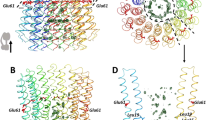Abstract
The catalytic portion (F1) of ATP synthases have the subunit composition α3, β3, γ, δ, ε. This composition imparts structural asymmetry to the entire complex that results in differences in nucleotide binding affinity among the six binding sites. Evidence that two or more sites participate in catalysis, alternating their properties, led to the notion that the interactions of individual αβ pairs with the small subunits must change as binding site properties alternate. A rotation of the γ subunit within the α3β3 hexamer has been proposed as a means of alternating the properties of catalytic sites. Evidence argues that the rotation of the complete γ subunit during ATP hydrolysis is not mandatory for activity. The γ subunit of chloroplast F1 may be cleaved into three large fragments that remain bound to F1. This cleavage enhances ATPase activity without loss of evidence of site-site interactions. Complexes of α3β3 have been shown to have significant ATPase activity in the absence of γ. Mg2+ATP affects the interaction of γ with the different β subunits, and induces other changes in F1, but whether these changes are induced by catalysis, or are fast enough to be involved in the catalytic turnover of the enzyme has not been established. Likewise, changes in structure and in binding site properties induced in thylakoid membrane bound CF1 by formation of an electrochemical proton gradient may activate the enzyme rather than be apart of catalysis. Mechanisms other than rotary catalysis should be considered.
Similar content being viewed by others
Abbreviations
- F1 :
-
catalytic portion of the ATP Synthase
- F0 :
-
membrane-associated, proton-translocating portion of the ATP Synthase
References
Abrahams, J. P., Leslie, A. G. W., Lutter, R., and Walker, J. E. (1994).Nature 370, 621–628.
Aggeler, R., Haughton, M. A., and Capaldi, R. A. (1995).J. Biol. Chem. 270, 9185–9191.
Bianchet, M., Ysem, X., Hullihen, J., Petersen, P. L., and Amzel, L. M. (1991).J. Biol. Chem. 266, 21197–21201.
Boyer, P. D. (1989).FASEB J. 3, 2164–2178.
Bruist, M. F., and Hammes, G. G. (1981).Biochemistry 20, 6298–6305.
Cross, R. L. (1992). InMolecular Mechanisms in Bioenergetics (Ernster, L., ed.), Elsevier, Amsterdam, pp. 317–330.
Cross, R. L., Grubmeyer, C., and Penefsky, H. S. (1982).J. Biol. Chem. 257, 12101–12105.
Duncan, T. M., Bulygin, V. V., Zhou, Y., Hutcheon, M. L., and Cross, R. L. (1995).Proc. Natl. Acad. Sci. USA 92, 10964–10968.
GrÄber, P., Schlodder, E., and Witt, H. T. (1977).Biochim. Biophys. Acta 257, 12030–12038.
Haughton, M. A., and Capaldi, R. A. (1995).J. Biol. Chem. 270, 20568–20574.
Hightower, K. E. (1996). Ph.D. thesis, Johns Hopkins University.
Hightower, K. E., and McCarty, R. E. (1996a).Biochemistry,35, 4846–4851.
Hightower, K. E., and McCarty, R. E. (1996b).Biochemistry,35, 4852–4857.
Leckband, D., and Hammes, G. G. (1987).Biochemistry 26, 2306–2312.
McCarty, R. E., Shapiro, A. B., and Feng, Y. (1988). InLight-Energy Transduction in Photosynthesis: Higher Plant and Bacterial Models (Stevens, S. E., and Bryant, D. A., eds.), The American Society of Plant Physiologists, Rockville, Maryland, pp. 290–304.
Miwa, K., and Yosida, M. (1989).Proc. Natl. Acad. USA 86, 6484–6487.
Nalin, C. M., Snyder, B., and McCarty, R. E. (1985).Biochemistry 24, 2318–2324.
Shapiro, A. B., and McCarty, R. E. (1990).J. Biol. Chem. 265, 4340–4347.
Sokolov, M., and Gromet-Elhanan, Z. (1996).Biochemistry 35, 1242–1248.
Strotmann, H., and Bickel-Sandkotter, S. (1984).Ann. Rev. Plant Physiol. 35, 97–120.
Turina, P., and Capaldi, R. A. (1994).J. Biol. Chem. 269, 13465–13471.
Turina, P., Aggeler, R., Lee, R. S. F., Senior, A. E., and Capaldi, R. A. (1993).J. Biol. Chem. 268, 6978–6984.
Yokoyama, K., Hisabori, T., and Yoshida, M. (1989).J. Biol. Chem. 264, 21837–21841.
Author information
Authors and Affiliations
Rights and permissions
About this article
Cite this article
Digel, J.G., Hightower, K.E. & McCarty, R.E. Subunit movement during catalysis by F1-F0-ATP synthases. J Bioenerg Biomembr 28, 439–442 (1996). https://doi.org/10.1007/BF02113986
Received:
Accepted:
Issue Date:
DOI: https://doi.org/10.1007/BF02113986




